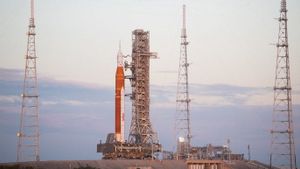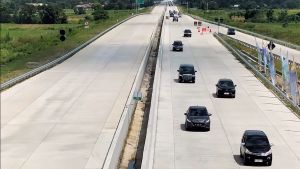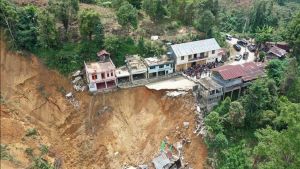JAKARTA - Authorities in Mexico are still searching for an uncontrolled Chinese rocket believed to have fallen back to Earth last week.
The 23-ton rocket was used to launch the third and final section of China's new space station at Tiangong on Monday, October 31 and was originally expected to return to Earth's atmosphere Tuesday morning, November 1.
However, the remnants of the rocket re-entered the atmosphere at 10:08 am UK time (6:08 pm Beijing time) Thursday 3 November.
Spain was identified as one of the countries on the rocket's path, which led to several Spanish airports closing their airspace.
But experts now believe that the rocket may have split in two as it slid Earth, with parts potentially hitting Mexican territory.
Jonathan McDowell, an astronomer at the Center or Astrophysics, tweeted: 'Some debris could have reached Puerto Escondido in Oaxaca. In fact, it's possible but unlikely that the debris would have made it as far as the province of Tabasco.'
VOIR éGALEMENT:
Bill Nelson, NASA administrator, has revealed that China does not share specific trajectory information from the space agency.
“Once again, the People's Republic of China is taking an unnecessary risk with the uncontrolled re-entry of their Long March 5B rocket stage. They don't share the specific trajectory information needed to predict landing zones and reduce risk," Nelson said.
Mengtian, or 'Heavenly Dream', joins Wentian as the second laboratory module for the station, which is collectively known as Tiangong, or 'Heavenly Palace'. The two are connected to the Tianhe core module where the crew lives and works.
When the rocket falls back, it will send out large and heavy debris, which will hit the earth's surface.
Debris from the rocket, flying around the world at a speed of 17.500 miles per hour, is being tracked live by EU Space Tracking and Surveillance.
It requires careful monitoring as it is one of the largest pieces of debris to re-enter the atmosphere in recent years.
At 10:33 a.m. GMT, US Space Command confirmed that the rocket had re-entered the atmosphere over the south-central Pacific Ocean.
Then at 12:06 p.m. GMT, they added that a second atmospheric re-entry had been confirmed in the Northeast Pacific Ocean region, indicating that the rocket may have split in two as it fell to Earth.
“The rocket fell. I suspect that it broke into two parts in the upper atmosphere on initial re-entry, and one of the halves was denser and lasted a little longer," McDowell tweeted.
So far there has been no confirmation of the appearance of the rocket debris.
"Uncertainty about where large debris will eventually land presents a level of risk to human safety and property damage that is well above generally accepted thresholds," Canadian astronomer Erika said in a tweet.
"If your latitude is higher than latitude France or Portland, Oregon, you're probably safe," says Erika.
The Chinese rocket measured 17.8 meters and had a diameter of 4.2 meters at the time of takeoff.
“This rocket is designed with special technology; most of the components will catch fire and be destroyed during the re-entry process, and the probability of causing damage to aviation and ground activities is very low," said Zhao Lijian, a spokesman for China's foreign ministry.
Like its predecessor, the Mengtian was launched on a Long March-5B carrier rocket, a member of China's most powerful launch vehicle family, all of which made an uncontrolled emergency landing back to Earth.
The Aerospace Corporation has previously said that there is "no zero chance" that debris will land in a populated area - in other words, that it is not impossible for rocket debris to land in a populated area.
"A re-entry of this magnitude would not burn up in Earth's atmosphere," said the Aerospace Corporation, based in El Segundo, California. "The general rule is that 20-40 percent of the mass of a large object will reach the ground, although that depends on the design of the object."
In a press conference on Wednesday, November 3, Ted Muelhaupt, a consultant for the Aerospace Corporation, said: 'We're starting again.'
The Philippine Space Agency earlier this week also warned that the debris fall zone may be near its islands.
The most recent is the rocket booster which was launched July 24 and because the booster runs around Earth's orbit every 90 minutes, the exact point at which the rocket will fall from the sky is impossible to predict.
Fortunately, most of the rockets burned up in the atmosphere, but up to 40 percent are predicted to survive a fall from space and some parts were found around South Asia on July 30. But according to reports there were no injuries from the rocket debris.
"All space exploration nations should follow established best practices and do their part to share this type of information in advance to enable reliable predictions of potential debris impact risks," Bill Nelson said in July.
"Doing so is essential for the responsible use of space and for ensuring the safety of people on this Earth," he added.
The English, Chinese, Japanese, Arabic, and French versions are automatically generated by the AI. So there may still be inaccuracies in translating, please always see Indonesian as our main language. (system supported by DigitalSiber.id)















